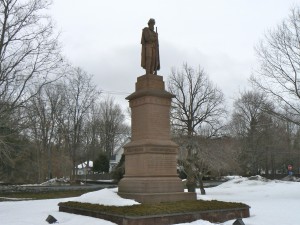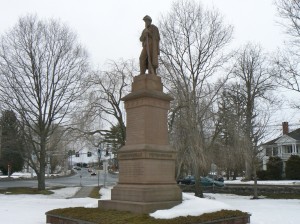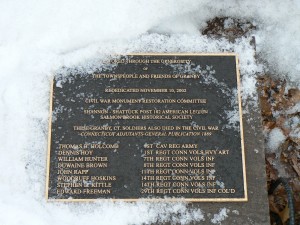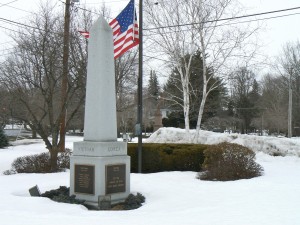 The first Civil War monument in Connecticut to display a figure stands on the green in Granby.
The first Civil War monument in Connecticut to display a figure stands on the green in Granby.
The brownstone Granby Soldiers’ Monument, dedicated in 1868, features contemplative bearded soldier holding a rifle while his overcoat is draped over his shoulders.
A dedication on the front (south) face reads, “This monument is erected by voluntary contributions in commemoration of the brave men from the town of Granby who laid down their lives for the Union in the War of the Great Rebellion. Erected July 4, 1868.”
The south face also lists the names of eight residents or natives killed in the war, and honors men who were held at the Confederate prisoner of war camp in Andersonville, Georgia.
 An inscription on the south side of the monument’s base reads, “They shall hunger no more, neither thirst any more.”
An inscription on the south side of the monument’s base reads, “They shall hunger no more, neither thirst any more.”
The east face lists 12 names, the battle of Petersburg, Virginia, and bears an inscription reading, “Faithful unto death.”
The north face lists seven names, including three affiliated with Massachusetts regiments, and honors the Battle of Cold Harbor, Va. The base is inscribed, “Death is swallowed up in victory.”
The west face lists eight names, honors the Battle of Antietam by listing Sharpsburg (Maryland), the town where it was fought.
In front of the monument, a bronze plaque describes a 2002 restoration of the monument and lists eight additional names of Granby residents lost in the war.
 Just south and east of the Civil War monument, a 1985 obelisk honors Granby’s World War II (11 residents lost), Korea and Vietnam (7 lost) veterans.
Just south and east of the Civil War monument, a 1985 obelisk honors Granby’s World War II (11 residents lost), Korea and Vietnam (7 lost) veterans.
The 1868 dedication data for the Civil War monument makes it among the first in the state, and it is the first Civil War monument in Connecticut to feature a figure. Earlier Civil War monuments in Kensington, Northfield, North Branford, Cheshire and other locations were obelisks.
The monument was supplied by James Batterson, a Hartford entrepreneur and monument dealer who provided many of the state’s Civil War memorials. On the Granby monument, Batterson listed himself as the sculptor, even though the actual carving was performed by staff sculptor Charles Conrads.
 Batterson’s firm also provided a nearly identical 1867 monument in Deerfield, Mass.
Batterson’s firm also provided a nearly identical 1867 monument in Deerfield, Mass.
Tags: Granby



